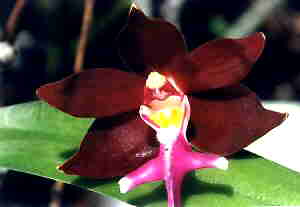|
|
|
CONTACT US
Click Here! |
| This site is best viewed with a screen resolution of 800 X 600 at high colour settings |
|
Flask list
Acacallis-Ancistrochilus Angraecum-Aspasia Barkeria-Broughtonia Bulbophyllum Capanemia-Catasetum Cattleya Cattleyopsis-Cycnoch, Cymbidium-Cyrtorchis Dendrobium-Dossinia Encyclia-Eulophiella Galeandra-Kalopternix Laelia-Lycaste Macodes-Nephalaphyll, Odontogloss,-Oncidium Paphiopedilum-Psychilis Rangaeris-Stenocoryne Tainia-Zygopetalum |
|
Plant list
Acampe-Bulbophyllum Cattleya-Dossinia Encyclia-Promeaea Renanthera-Vanda |

BP SPECIES NEWSLETTER February 2002July00 Aug Sept Oct Nov Dec Jan01 Feb Mar April MayJune July August September October November December January02
Trichoglottis brachiata above, Dend. jenkensii, Sarcochilus falcatus, Sarcochilus cecileae, Sarcochilus roseusDo you know any orchid growers who may like to receive this newsletter? Why not forward this email to them now!A b&w printed copy of this Newsletter can be mailed each month if you send 12 Australian stamps or 12 International reply coupons to Burleigh Park Orchid Nursery, 54 Hammond Way, Thuringowa, Australia 4815.Items in this newsletter may be reproduced provided source acknowledged.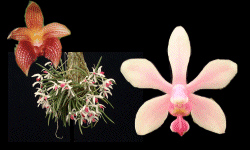
We commend "Orchids Online Web Design" for the excellent work on our web site and this Newsletter.Have a look now at some of the 550 new orchid photos pages just up at Steve's website at Orchids OnlineA. What's New in flask.Dendrobium vandoides, a Grastidium section species from New Guinea, where it grows in thick moss and leafmould on top of large rock outcrops. A warm grower, it will develop into a large leafy plant and produce frequent flowerings at the stem nodes. Flowers are cream spotted red.Gongora truncata, a showy Punch & Judy orchid. Cream flushed orange, lip white. Best grown under intermediate conditions, in a small pot or basket, preferably hanging to accomodate the long pendulous spike. The media should be damp but not wet, and care should be taken not to overwater the plant when it is not in active growth. Trichoglottis brachiata, a warm grower, likes a post to clamber up. For a full article dealing with Trichoglottis, go to Another Trichoglottis B. What's ready to replate NOW.Summer is here in the Australian tropics, it's hot and wet. While the Brazilian Sophronitis are more intermediate growers, the Sophronitis species, S. cernua, S. wittigiana, S. coccinea and S. brevipedunculata are growing strongly in the mother flasks, ready for the final replate. Minature growers, best results are had using a piece of treefern, but small pots can also be used with a well drained media. The orange, rose, scarlet and red colours, in that order, of the quite large flowers relative to the minature plants, make these showy additions to the orchid house. A bright sunny spot is needed. We recommend that you order flasks for delivery in Spring, so if you live in the Northern Hemisphere, NOW is the time to plan for Spring.C. What's new in Plants.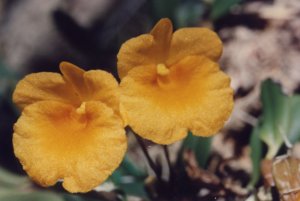 Dendrobium mimiense, a species from New Guinea which is very similar to Dendrobium capituliflorum. A few near flowering size plants are growing well on pieces of cork, but this easy to grow species will grow in almost any media. A typical Dendrobium in culture, good drainage and bright light will produce a plant with masses of white and green "pompom" like heads of flowers.
Dendrobium mimiense, a species from New Guinea which is very similar to Dendrobium capituliflorum. A few near flowering size plants are growing well on pieces of cork, but this easy to grow species will grow in almost any media. A typical Dendrobium in culture, good drainage and bright light will produce a plant with masses of white and green "pompom" like heads of flowers.
Dendrobium jenkensii is the minature growing species that looks like a dwarf Dendrobium aggregatum. The flowers are about 4 cm across, bright orange. This species will form a mat on a piece of treefern or cork with extra water. It will also grow well in a small basket in a well drained media. A rest in winter is required, and intermediate conditions although it is dormant during the cold winter, so is adaptable. Flowering size plants are well established on pieces of cork. Laelia purpurata sanguinea. This is the Brazilian species that grows much like a Cattleya, and is the red, red purple coloured form of a extremely variable colour range. Seedlings are growing well in small slotted pots in a spagh/isolite mix that is well crocked. A well drained media, lots of sunlight and good ventilation are the requisites for successful Laelia purpurata culture. TOP D. Culture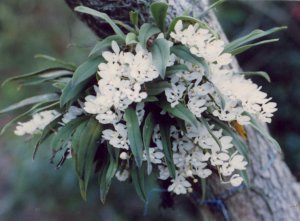 To understand the culture of the Australian Sarcochilus, it is useful to know how they grow in the wild. Below are described a few different species of Sarcochilus, their native habitat and their orchidhouse requirements.
To understand the culture of the Australian Sarcochilus, it is useful to know how they grow in the wild. Below are described a few different species of Sarcochilus, their native habitat and their orchidhouse requirements.
Sarcochilus falcatus is a species of the higher elevations and intermediate climate. It does not grow in the hot lowlands, and is usually found growing on the main trunk or branches of trees. It is also sometimes a lithophyte, on a mossy boulder. The plants are usually well exposed to the elements, but under considerable shade, and in the drier months, can become quite shrivelled and stressed until the next rainfall. So with the knowledge of its wild habitat, this species must have a well drained mount, with perhaps a little moss under the roots, a shady position and good air movement. When the plant is not growing, in the cooler months as in its native habitat, less water is required. 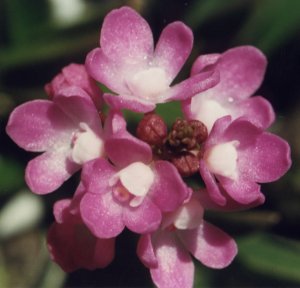 Sarcochilus cecileae is a rock grower, often in almost full sun, in intermediate to warm climate conditions. In North Queensland, it is seldom found below 1000 ft altitude. Usually found growing in rock crevices in the collected leafmould from open forest trees, gravel and other debris. The plants are well exposed to both the elements and sunlight, and the growing
season corresponds with the prevailing wet season. Plants are sometimes found at the base of small trees that grow out of the rock face, but usually with their roots well into the leafmould and sometimes gravely debris found in the crevice. In the dry season, plants are usually well stressed, almost dry, hardly appearing to be alive.
So this rock grower requires a well drained container, a shallow clay pot is ideal, with a media that will drain well. Maximum ventilation is essential, too much water quickly rots the plant, and a bright sunny position is needed. Plants will grow in the shade into quite lush specimens, but are then reluctant to flower.
In the cooler, drier months, very little water is needed and should be withheld to avoid damp out and rotting of the plants.
Sarcochilus cecileae is a rock grower, often in almost full sun, in intermediate to warm climate conditions. In North Queensland, it is seldom found below 1000 ft altitude. Usually found growing in rock crevices in the collected leafmould from open forest trees, gravel and other debris. The plants are well exposed to both the elements and sunlight, and the growing
season corresponds with the prevailing wet season. Plants are sometimes found at the base of small trees that grow out of the rock face, but usually with their roots well into the leafmould and sometimes gravely debris found in the crevice. In the dry season, plants are usually well stressed, almost dry, hardly appearing to be alive.
So this rock grower requires a well drained container, a shallow clay pot is ideal, with a media that will drain well. Maximum ventilation is essential, too much water quickly rots the plant, and a bright sunny position is needed. Plants will grow in the shade into quite lush specimens, but are then reluctant to flower.
In the cooler, drier months, very little water is needed and should be withheld to avoid damp out and rotting of the plants.
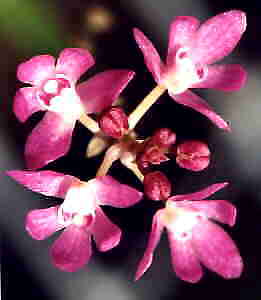 Sarcochilus roseus is a species very closely related to S. cecileae and is grown the same way. It is a plant of the edges of tropical rainforest, at a much lower elevation than S. cecileae, also lithophytic. Thus S. roseus will tolerate somewhat warmer conditions, and when in growth, usually after it flowers, somewhat wetter conditions, but air movement and ventilation is also essential.
Sarcochilus roseus is a species very closely related to S. cecileae and is grown the same way. It is a plant of the edges of tropical rainforest, at a much lower elevation than S. cecileae, also lithophytic. Thus S. roseus will tolerate somewhat warmer conditions, and when in growth, usually after it flowers, somewhat wetter conditions, but air movement and ventilation is also essential.
Sarcochilus hartmanii is a large growing species that inhabits rock faces. There it grows in quite exposed conditions, in rock crevices and on rock shelves, in the accumulated leafmound and broken rock and gravel. It is an intermediate to cool species, not a tropical species, but reasonably tolerant of higher temperatures. So it also requires a well drained container, a shallow clay pot is ideal, with a media that will drain well. Maximum ventilation is essential, too much water quickly rots the plant, and a bright sunny position is needed. Sarcochilus tricalliatus, along with S. hillii, and others of the smaller minature species, are twig growers in the drier scrubs. In a good season, these plants swarm thru the low growing shrubby trees, flourishing on the twigs and stems in fairly heavy shade. In a poor season, with the fall of twigs and lack of rain, the swarms seem to disappear, to emerge again from a few survivers in the next good season. Good and bad seasons are dependent on the seasonal rains. So Sarcochilus tricaliatus and its like require a long thin mount, a twig, lots of water in the growing season, a shady spot and a good dry rest in the cooler drier times. Air movement and ventilation is essential, none of the Sarcochilus appreciate damp dank conditions for long. S.tricalliatus is a tropical species, most of the other minature species are cool to intermediate growers. E. Did you know ?Email messages 1; emails with embedded photographs can be rejected by some computers, so this Newsletter may not reach all intended recipients.Email messages 2; messages sent without a pertinent subject should be deleted without delay and attachments to these should not be opened in case of virus. If you send an email without a pertinent subject, it will be deleted unread. We suggest that when sending an email, the subject should be something that only the recipient will understand in context, ie Request flask list if sent to Burleigh Park Orchid Nursery. Email messages 3; Emails should have the sender identification as your name, not your email address or a code, ie Ian Walters, not zippo@net.xx . We all understand the need for caution when on the Web, and there is a constant need to be alert for virus. Important notice to European Importers. As from 1st January, Australian Banks will only accept Euro currency from most European countries. Cheques and cash will have to be in Euro currency, the Australian Banks will not accept the old currency ie Francs, Deutshmarks etc. Parcels sent by Air Courier internationally can be traced on the Internet. Waybill number and contact phone number for your locality are advised at time of shipment, as well as the web address for the courier. It is very helpful if the Courier also has YOUR phone number. In the December Newletter, Pescatoria lehmanii was incorrectly labelled as Cochleanthes lehmanii. F. Humour.A group of chess enthusiasts checked into a hotel and were standing in the lobby discussing their recent tournament victories. After about an hour, the manager came out of the office and asked them to disperse."But why?" they asked, as they moved off. "Because," he said, "I can't stand chess nuts boasting in an open foyer." The furniture salesman was back from a Paris convention. What a time I had, went to a night club, met a beautiful girl, we dined and danced and laughted all night, even tho we could not understand each other. At the end of the night, she draws this picture of a bed on the menu. Now, I ask you, how did she know I was in the Furniture business? Hear about the man who crossed a lion and a tiger and got a liger? What about the farmer who crossed a field with a milk maid and got nothing? G. A special note on flasking orchids.Due to the need for a filtered air vent on flasks to allow exchange of gasses, a reliable air filter medium is needed.Non absorbant cotton wool allows gas exchange but does not absorb moisture. Thus the air filter will stay dry and prevent the growth of fungus thru the filter, a common problem with ordinary cotton wool which gets wet, goes mouldy and allows the mould to grow thru the filter to contaminate the flask. Non Absorbant Cottonwool NOW AVAILABLE in 375 gram rolls, contact us NOW. |
Designed and maintained by
Orchids Online Web Design
© All rights reserved.
